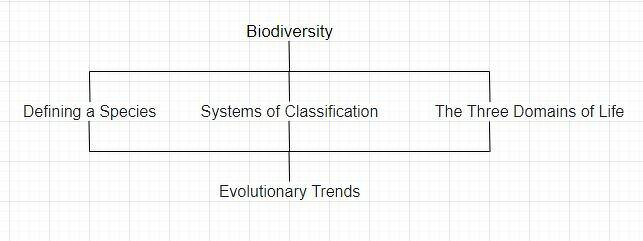Answer:
Complete answer is given below.Step-by-step explanation:

In this representation, "Biodiversity" is at the center, connecting to different key concepts. The lines indicate relationships, and each concept is briefly explained.
Part 1
Defining a Species:
Connection to Classification: The definition of a species is crucial in classification. A species is often defined as a group of organisms that can interbreed and produce fertile offspring. This definition is fundamental to organizing and categorizing organisms into distinct groups, facilitating a systematic approach to understanding biodiversity.
Systems of Classification:
Link to Defining a Species: Systems of classification, such as taxonomy, rely heavily on the definition of a species. Classifying organisms into hierarchical groups based on shared characteristics allows scientists to organize and communicate information about the diversity of life. The criteria used in classification often stem from the characteristics that define a species.
Biodiversity:
Relation to Evolutionary Trends: Biodiversity encompasses the variety of life on Earth, including the number and abundance of different species. Understanding and defining biodiversity are essential for tracking evolutionary trends. The richness of species in different ecosystems provides insights into how life has evolved over time and how various species adapt to their environments.
The Three Domains of Life:
Integral to Classification: The three domains of life (Bacteria, Archaea, and Eukarya) are major divisions in the classification of living organisms. This classification is based on fundamental differences in cellular structure and genetic makeup. Understanding these domains is pivotal in deciphering the evolutionary relationships among living organisms.
Evolutionary Trends:
Interconnected with Biodiversity: Evolutionary trends reflect the changes in species over time. Biodiversity is a direct result of these trends, showcasing the adaptations and variations that have occurred. The study of evolutionary trends helps scientists comprehend the processes that have shaped the diversity of life, highlighting the importance of biodiversity.
Part 2
Why Each Idea is Considered "Big":
Defining a Species: The concept of a species is foundational in biology, providing a baseline for understanding the diversity of life.
Systems of Classification: A systematic approach to classifying organisms is vital for organizing information, enabling effective communication, and forming the basis for further biological studies.
Biodiversity: The richness and variety of life contribute to ecosystem stability, resilience, and the potential for discoveries in various fields, including medicine and conservation.
The Three Domains of Life: Understanding the major divisions of life is crucial for deciphering evolutionary relationships and highlighting the unity and diversity among living organisms.
Evolutionary Trends: Studying how species change over time provides insights into the mechanisms driving biodiversity, offering a comprehensive view of the history of life on Earth.